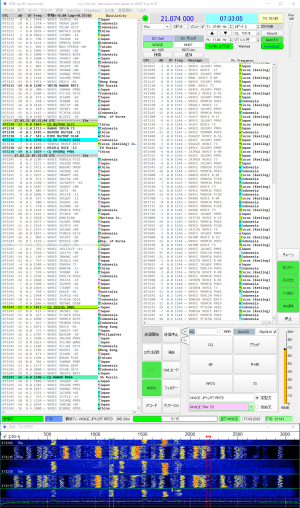The English article is after the Japanese one.
WSJT-X 2.4.0 -rc3をFT8運用にお使いの方、結構いらっしゃるのではないでしょうか。
RRR "の送信を選択された方は、WSJT-Xの動作がおかしいと感じていませんか?
通常、"RRR "を送信した後、QSO相手は "73 "を送信して、自分も"73"を送ってQSOを終了します。しかし、WSJT-X 2.4.0 -rc3では、相手から "73 "を受信しても、相手に "73 "を返しません。"RR73"と同様の動作をします。
私はJTDXユーザーですし、RR73を送る設定しているので何も問題はないのですが。
QSOを完了させるためには、"73"が必要だという人もいます。しかし、この新しいWSJT-X Auto Seqの動作が2.4.0 GA版でデフォルトとして採用された場合、そのような方々は無効で不完全なQSOであるため、きっと多くのQSOをログに付けないのでしょうね。その方達はもしGA版で採用されたらものすごく損をすると思いますが。まあ、RR73を送る設定にすれば何も問題はないですけれども。
あるWSJT-Xユーザーが、この動作の理由を尋ねたところ、開発チームのメンバーは、"あなたが送りたい余分な73メッセージの目的は何ですか?"と答えたそうです。 もしそうであれば、この動作はバグではなく、開発チームの意図であると考えられます。
皆さんはどのようにお感じになりますか?
ちなみにJTDX開発チームからのメールによると「一般的には、JTDXはこの変更に何の問題もありません。(RRRを送信して73を受信した後に)自分の最後の73メッセージを送信する1つのTx期間が失われるだけで、他の人に害を与えることはありません。WSJT-XはRRRとRR73を同じものとして解釈し、将来的には1つのメッセージタイプを他の意味に解放しようとしているようにみうけられる。」と回答しています。
この変更に対するアクションは、"RRR "の送信をやめて、"RR73 "に変更するだけです。全員が「RR73」を送信するように設定されていれば、何の問題もありません。しかし、中には「RRR」の送信にこだわる人もいて...。
どうしても「RR73」を送りたくない理由のひとつに、「RR73」というグリッドロケータがあるからというのがありますが、ここは北極点の近くで陸地がないので、実害はありません。
リリースされたばかりのrc4でも動作は同じでした。なのでこれはバグではなくて仕様変更だと思います。
------------------------------------
Many of you are using WSJT-X 2.4.0 -rc3 for FT8, I guess.
If you have chosen to send "RRR", do you feel that WSJT-X is behaving strangely?
Normally, after sending "RRR", the QSO partner will send "73", and then send "73" to end the QSO.
I'm a JTDX user, and I have "RR73" set to send, so there's nothing wrong with that.
However, WSJT-X 2.4.0 -rc3 does not return "73" to the other party after receiving "73" from the other party. It behaves just like "RR73".
Some people say that "73" is required to complete a QSO. However, if this new WSJT-X Auto Seq behavior is adopted as the default in the 2.4.0 GA version, I am sure they will not log many QSOs because those are what they call incomplete and invalid QSOs by their own definition.
I think those people will lose a lot of QSO if this adopted with the GA version. Well, there's no problem if you set it to send RR73.
When one WSJT-X user asked why this behavior was happening, a member of the development team replied, "What is the purpose of the extra 73 messages you wish top send?" If this is the case, then this behavior is not a bug, but the intention of the development team.
By the way, according to an email from the JTDX development team, "In general JTDX has no problems with this change, It just will lose one tx period sending own last 73 message (after sending RRR and receiving 73) and this will not harm others to.
Looks like they will interpret RRR and RR73 as same and try free one message type for other meanings in future. "
The action for this change is to stop sending "RRR" and just change it to "RR73". If everyone was set to send "RR73", there would be no problem. However, there are some people who insist on sending "RRR"...
One of the reasons they insist on not sending "RR73" is because there is a grid locator "RR73", but since it is near the North Pole and there is no land, there is no real harm.























最近のコメント